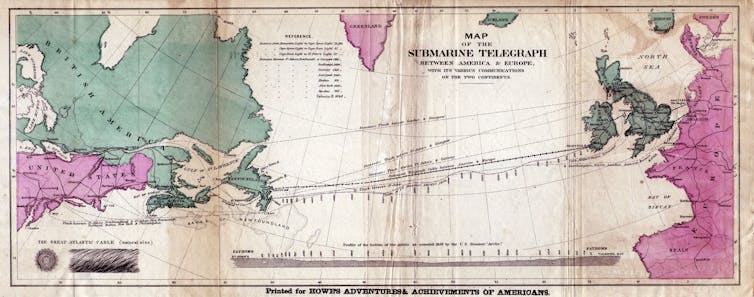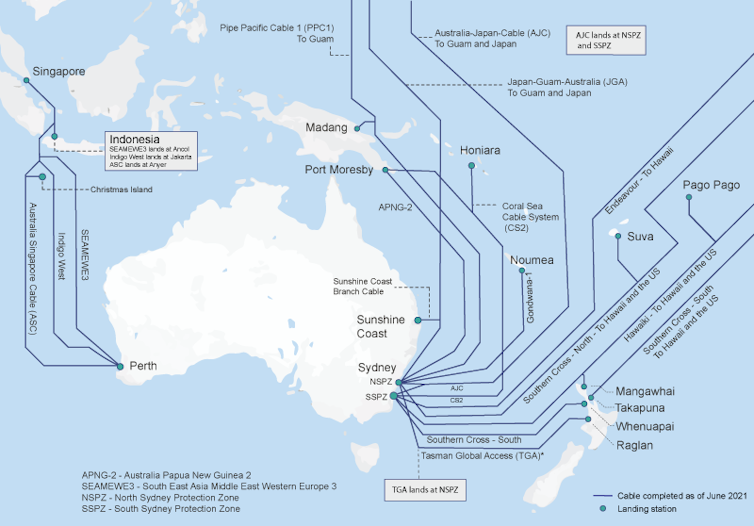The Australian government this week announced it will spend $18 million over four years on a new facility aimed at protecting the undersea cables that power the country’s internet.
The Cable Connectivity and Resilience Center is responsible for protecting undersea communication cables throughout the Indo-Pacific region from malicious interference, or accidental damage.
This is a very important job. The Internet directly contributes $167 billion or more annually to the Australian economy. These networks support everything from social media updates to the big things that drive the world’s economy.
But what is prompting Australia’s urgent need to better protect these important cables now?
The backbone of the internet
Submarine telecommunications cables are laid under the sea at depths of up to 8,000 meters. They trace their roots back to the mid-19th century, driven by business and the need for royal authority.
The British Empire invested in these cables to connect and control its distant territories. In fact, they are called “the nervous system of the British Empire”.
The first transatlantic cable in 1858 demonstrated the potential for rapid intercontinental communication. This revolutionized business and leadership.

Howe’s Adventures & Achievements of Americans/Wikimedia Commons
These pipes are usually no larger than a garden hose. They consist of transparent fibers covered in thick plastic for protection. They can transmit data from one end of the cable to another at a speed of 300 terabits per second.
For news, 20 terabits per second can stream about 793,000 high-definition videos simultaneously. With a speed of 300 terabits per second, the possibilities for using digital data are limitless.
There are currently about 1.4 million kilometers of submarine cables in operation around the world. Only 15 known international cables carry 99% of Australia’s data traffic.
What will the new location do?
The new facility will provide technical assistance and training to the Indo-Pacific. It will also help other governments in the region to develop a better policy for submarine cables.
This continues Australia’s long-standing commitment to protecting submarine cables from threats such as accidental damage by fishing or attack by malicious actors, including government and non-government organizations.

ACMA
In 2011, Australia was the first country to join the International Cable Protection Committee.
Australia has designated protected areas with strict rules for submarine cables. Some countries and trade unions see this as the gold standard.
Australia has launched a new Cable Connectivity and Resilience Center to tackle the challenges posed by high reliance on the internet.
But the global development of techno-politics has also played an important role.
New threats
Artificial Intelligence (AI) has become a prominent part of the United States-China competition for technological dominance. And we can access AI tools from the Internet thanks to submarine cables.
Advances in AI can also revolutionize productivity, industry and innovation. AI is already being used in medical research, diagnostics, banking and transportation planning. And the security sector is increasingly relying on AI for data analysis and advanced tools.
This also underlines the urgent need for strong data protection – which includes keeping submarine cables safe.
So the new Cable Connectivity and Resilience Center is not just a financial one. It is also important for national security. It allows Australia to position itself as a key player in digital security in the region.
Nuance is important
But the unique nature of undersea cable technology requires a flexible approach.
Although it is staffed by the Australian government, the success of the new facility depends on close collaboration with industry experts who have experience in the design, installation and management of cables.
This partnership is crucial in addressing physical and digital challenges, and managing complex industries and geopolitical changes.
The control of technology giants such as Google and Amazon is another problem. He oversees more than 20% of new subsea cable installations in the cable industry.
The new central government must balance the interests of the country and regulate the industry so that it does not waste energy. This is especially important because the main technology is growing rapidly.
The government says the new facility is an important contribution to the Quad – a diplomatic partnership between Australia, India, Japan and the US. But the center should also cooperate with other international organizations.
For example, Australia can learn from countries such as Singapore, which has cable management systems. This includes plans to increase Singapore’s cable network by 2033.
Involvement in the Quad countries will also strengthen Australia’s digital infrastructure.
A new way forward
The newly announced Cable Connectivity and Resilience Center marks a change in Australia’s approach to digital security.
Historically, Australia has argued that it has Chinese technology. This is evidenced by his rejection in 2016 of Huawei’s request to build the Coral Sea Cable, citing national security.
However, the fact that the new location is within the Department of Foreign Affairs and Trade indicates a change in the communication process.
It reflects Australia’s intention to reduce China’s influence in subsea defence, AI and technology and align national security with diplomatic cooperation.
Will it work? Only time will tell. But the shift from conflict to diplomacy is a welcome development. This could help Australia navigate the complex global technology landscape.
#underwater #cables #connect #Australia #rest #world #vulnerable #fishing #boats #spies #natural #disasters